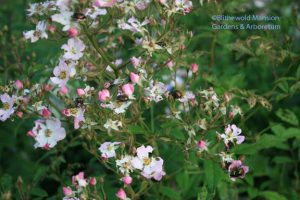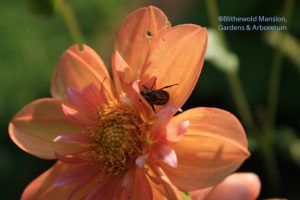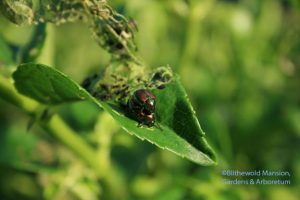The beetle battle
Rated NC 39 for graphic bug sex, violence and strong language
 In a garden as beautiful as this (the North Garden this very morning) you might not be aware at first glance of the horrors lurking within and on top. But they’re here. The first Japanese beetle was sighted (by me) on July 6th and was ceremoniously snipped in half with an invective and a flourish (also by me). Ever since that day, we’ve had cans of soapy water at the ready and homicide in our hearts.
In a garden as beautiful as this (the North Garden this very morning) you might not be aware at first glance of the horrors lurking within and on top. But they’re here. The first Japanese beetle was sighted (by me) on July 6th and was ceremoniously snipped in half with an invective and a flourish (also by me). Ever since that day, we’ve had cans of soapy water at the ready and homicide in our hearts.
Normally I’m a very live-and-let-live sort of person. I don’t always mind an aphid or 2 and I generally think the bunnies in the garden are wicked cute and occasionally photogenic. But when it comes to wholesale destruction of something I love – particularly any plant in one of my favorite gardens, I lose my cool. Gail and I would never ever consider spraying poisonous chemistry to kill pests – it’s just not worth the risk to the volunteers’, visitors’ and our health – or the health of bugs we need and want in the garden. But I think nothing of hand picking, squishing (if I’m wearing gloves), drowning or feeding certain pests to the birds. (That said, our resident hawk family has been hard at work on the bunny population without any help from me.)
 Japanese beetles feed on upwards of 300 species of plants and nothing in this part of the world feeds on them. There’s something wrong with that picture, isn’t there? So we try to do our top-of-the-food-chain best to control the population ourselves. We actually thought we might have put a dent in the numbers when we were planting this spring – every hole we dug was full of white grubs which of course we squished on sight. But I guess we weren’t able to get them all. We also have a population of Oriental beetles which are slightly smaller and a boring striped brown rather than the metallic auto body green of the Japanese beetles.
Japanese beetles feed on upwards of 300 species of plants and nothing in this part of the world feeds on them. There’s something wrong with that picture, isn’t there? So we try to do our top-of-the-food-chain best to control the population ourselves. We actually thought we might have put a dent in the numbers when we were planting this spring – every hole we dug was full of white grubs which of course we squished on sight. But I guess we weren’t able to get them all. We also have a population of Oriental beetles which are slightly smaller and a boring striped brown rather than the metallic auto body green of the Japanese beetles.  The really disgusting thing about the beetles is that they tend to feed in sort of orgiastic pig piles. According to my favorite bug book, Garden Insects of North America by Whitney Cranshaw, “The aggregation pheromones these insects produce combined with attractive odors produced by food plants often result in large numbers feeding together.” But that does make it so much easier to knock bunches at once into the beetle juice can… I remember thinking last year that there were fewer beetles and I wonder if it’s too soon to say that there are even less so far this year. Maybe the milky spore disease that Dan spread 3 years ago now is kicking in – and maybe, just maybe hand picking isn’t just a cathartic serial killing spree for us. Maybe we are actually slowing them down. Fingers crossed. And here’s a helpful hint if happen to be looking for one: They’re sleepy early in the morning. By mid morning on a hot day they’re more likely to see you coming and fly into your hair.
The really disgusting thing about the beetles is that they tend to feed in sort of orgiastic pig piles. According to my favorite bug book, Garden Insects of North America by Whitney Cranshaw, “The aggregation pheromones these insects produce combined with attractive odors produced by food plants often result in large numbers feeding together.” But that does make it so much easier to knock bunches at once into the beetle juice can… I remember thinking last year that there were fewer beetles and I wonder if it’s too soon to say that there are even less so far this year. Maybe the milky spore disease that Dan spread 3 years ago now is kicking in – and maybe, just maybe hand picking isn’t just a cathartic serial killing spree for us. Maybe we are actually slowing them down. Fingers crossed. And here’s a helpful hint if happen to be looking for one: They’re sleepy early in the morning. By mid morning on a hot day they’re more likely to see you coming and fly into your hair.
Have your beetles emerged yet? Do you have homicide in your heart?

